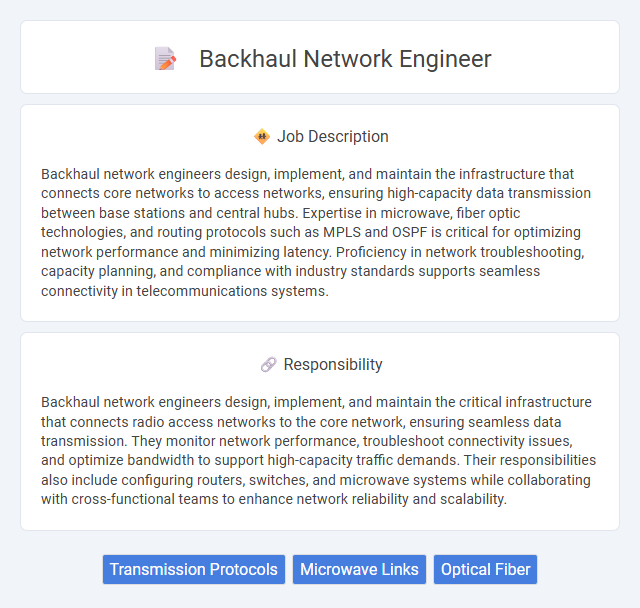
Backhaul network engineers design, implement, and maintain the infrastructure that connects core networks to access networks, ensuring high-capacity data transmission between base stations and central hubs. Expertise in microwave, fiber optic technologies, and routing protocols such as MPLS and OSPF is critical for optimizing network performance and minimizing latency. Proficiency in network troubleshooting, capacity planning, and compliance with industry standards supports seamless connectivity in telecommunications systems.
Individuals with strong analytical skills and a keen interest in telecommunications are likely to thrive as Backhaul Network Engineers. Those who enjoy troubleshooting complex network issues and working in high-pressure environments may find this role suitable. Candidates less comfortable with continuous learning and adapting to rapidly evolving technologies might face challenges in this position.
Qualification
A Backhaul Network Engineer requires in-depth knowledge of telecommunications infrastructure, including fiber optic systems, microwave links, and network protocols such as MPLS and Ethernet. Proficiency in network design, troubleshooting, and performance optimization is essential, alongside certifications like CCNP, JNCIP, or equivalent in network engineering. Strong analytical skills and experience with network management tools and GIS mapping software enhance the ability to deliver reliable and scalable backhaul solutions.
Responsibility
Backhaul network engineers design, implement, and maintain the critical infrastructure that connects radio access networks to the core network, ensuring seamless data transmission. They monitor network performance, troubleshoot connectivity issues, and optimize bandwidth to support high-capacity traffic demands. Their responsibilities also include configuring routers, switches, and microwave systems while collaborating with cross-functional teams to enhance network reliability and scalability.
Benefit
Backhaul network engineers likely experience significant career benefits, including opportunities for skill advancement in telecommunications infrastructure and enhanced job security due to increasing demand for reliable data transmission. The role may offer competitive salaries and potential for career growth within network architecture and optimization. Employers might also provide access to cutting-edge technology and training, improving long-term professional development.
Challenge
Backhaul network engineers likely face challenges related to optimizing the capacity and reliability of data transmission between core networks and access points, especially in high-traffic urban areas. Troubleshooting network bottlenecks and mitigating interference may require advanced technical skills and rapid problem-solving under pressure. The evolving nature of telecommunication technologies probably demands continuous learning to manage complex, large-scale network infrastructures effectively.
Career Advancement
Backhaul network engineers play a critical role in maintaining and optimizing telecommunications infrastructure, handling high-capacity data transmission between core networks and access points. Career advancement in this field often involves progressing to senior engineering roles, specializing in network architecture design, or transitioning into management positions such as network operations manager or telecommunications project lead. Continuous skill development in emerging technologies like 5G, software-defined networking (SDN), and network function virtualization (NFV) significantly enhances promotion prospects and salary potential.
Key Terms
Transmission Protocols
Backhaul network engineers specialize in designing, implementing, and maintaining high-capacity transmission protocols such as MPLS, SDH, and DWDM to ensure efficient data transport across telecommunications networks. Mastery of protocols like OTN, SONET, and Ethernet plays a critical role in optimizing bandwidth, reducing latency, and securing reliable connectivity for mobile and fixed network infrastructures. Expertise in protocol integration and troubleshooting directly impacts network resilience and performance within 4G, 5G, and fiber-optic backhaul systems.
Microwave Links
Backhaul network engineers specialize in designing, deploying, and maintaining microwave link systems that ensure high-capacity, low-latency wireless communication between base stations and core networks. Their expertise includes frequency planning, radio propagation analysis, and troubleshooting signal interference to optimize network reliability and performance. Proficiency in microwave transmission protocols and alignment of parabolic antennas is essential for maximizing link efficiency in cellular and broadband infrastructure.
Optical Fiber
Backhaul network engineers specializing in optical fiber design, implement, and maintain high-capacity fiber optic networks that connect core networks to edge devices, ensuring reliable data transmission over long distances. They optimize signal integrity, manage fiber splicing, and troubleshoot physical layer issues to enhance network performance and reduce latency. Expertise in DWDM, fiber testing tools, and network protocols is critical for maintaining efficient and scalable backhaul infrastructure.
 kuljobs.com
kuljobs.com